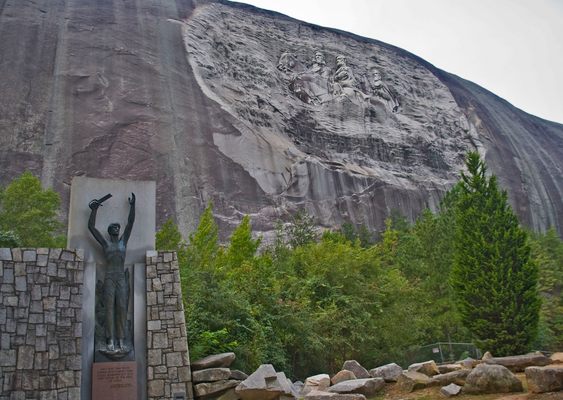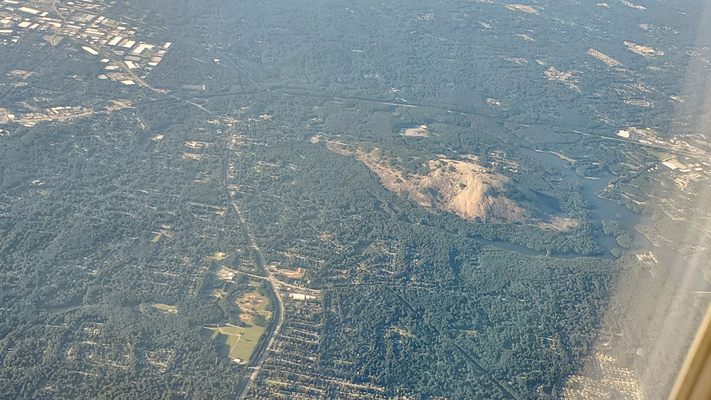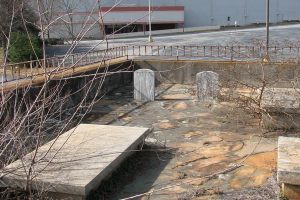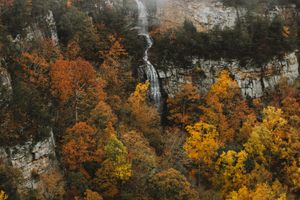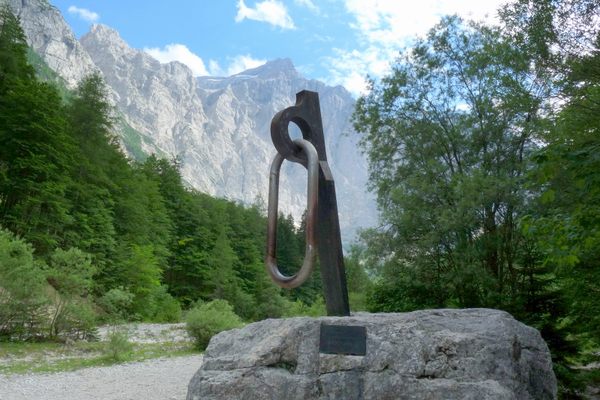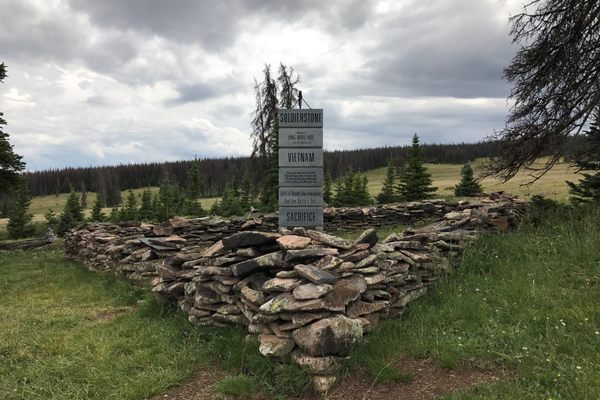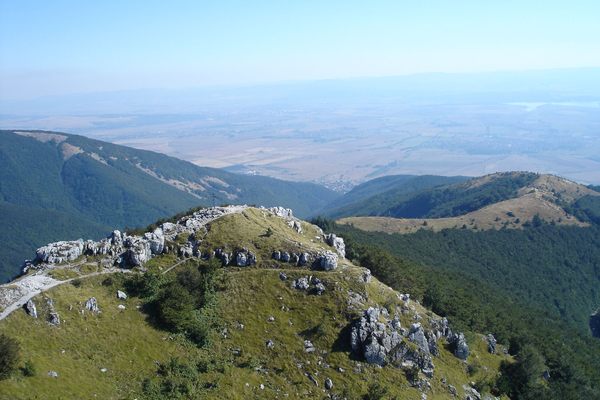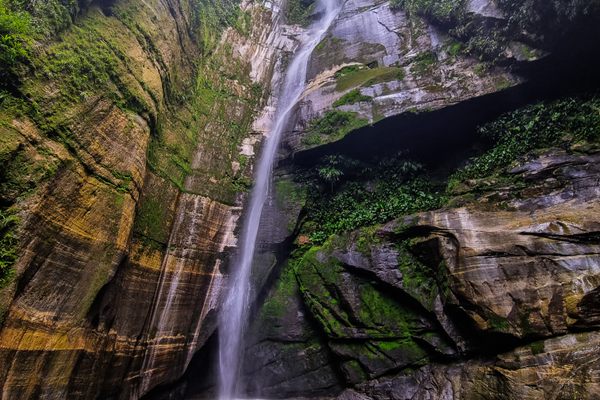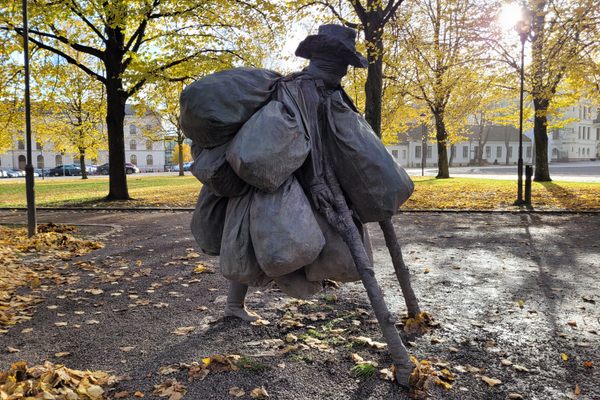About
Stone Mountain is a lot of things: a park with beautiful hiking trails and rare flora; a lakeside mountain with lush picnicking spots, a scenic railroad, and an aerial tramway; the place to see a popular and no doubt spectacular laser light show. The main thing that initially jumps out about Stone Mountain, though, is that it bears a gigantic bas-relief carving that serves as a memorial to the Confederate States of America.
For most of the 300-some-odd-million years this 825-foot hulking granite sentry of the Blue Ridge Mountains has brooded over its environs, it had nothing to do with the Confederacy at all. Stone Mountain was an important meeting place for the Creek Confederation and the Cherokees during the period of European encroachment into the region. Starting in the 1830s and for several decades thereafter, granite was quarried at Stone Mountain — granite which went on to build locks at the Panama Canal, vaults at the U.S. Treasury, and the East Wing steps of the U.S. Capitol, among other things.
As early as 1850, it was a popular outdoor destination for visitors from nearby Atlanta, and understandably so; it's a naturally striking and attractive place. Which is why early-20th-century white supremacists decided to make this remarkable geological formation their own, and that — like so many ramifications of history — remains inescapable unto the present day.
And make no mistake: the originators of this memorial were white supremacists, and not just people "interested in Southern history." The concept for the memorial carving was first conceived of by C. Helen Plane. A charter member of the United Daughters of the Confederacy, Plane originally envisioned a memorial depicting Robert E. Lee heroically leading not only Confederate soldiers, but also Ku Klux Klansman. The UDC started advocating for the creation of the monument at Stone Mountain in 1914; in 1915, the second iteration of the KKK was founded on top of Stone Mountain; and in 1916, Sam Venable — one of the owners of Stone Mountain, as well as a Klansman — granted the UDC permission to begin creation of the Confederate memorial on the north face of the mountain.
This first attempt to build the monument flailed for 12 years, and ultimately ceased in 1928, having gone through two sculptors (the first being Gutzon Borglum, who went on to begin Mount Rushmore, and was also a Klansman) with only a completed carving of Lee's head to show for it. Stone Mountain continued to be closely associated with the KKK, as Sam Venable granted the group an easement in 1923 giving them "perpetual right to hold celebrations as they desired." The Confederate memorial, however, lay unfinished and dormant.
In 1958, the State of Georgia purchased Stone Mountain with an eye toward reviving and completing the memorial, at a time that coincided with the Civil Rights Era. The State of Georgia went through the process of condemning the property after buying it, thus eliminating the easement held by the KKK. Work began anew using an updated design — no Klansmen this time, just Robert E. Lee, Thomas "Stonewall" Jackson, Jefferson Davis, and their beloved horses — and was completed in 1972. Measuring 76 feet by 158 feet and covering 1.57 acres, it is the largest bas-relief sculpture in the world.
Stone Mountain is a remarkable geological formation within a beautiful (if somewhat amusement-oriented) park most notable for a massive sculpture with an unpleasant history, depicting in granite, three men looking down over a present world they fought to prevent. In October 2015, the Stone Mountain Memorial Association announced plans to build a "Freedom Bell" monument to Martin Luther King, Jr. (a Georgia native) on the summit of Stone Mountain, which was referenced in his famous "I Have a Dream" speech.
The laser light show recently added three flame cannons, and looks impressive.
Related Tags
Know Before You Go
Admission to the park costs $20 per vehicle for parking and basic access, but it costs extra for some attractions like the aerial tram. A membership program is offered. The park is open year-round, however the laser show only runs from late spring to early fall. Showtimes are subject to change, and the show may be canceled due to unfavorable weather conditions, so make sure to check the park's website before you visit.
Community Contributors
Added By
Sources
- http://www.georgiaencyclopedia.org/articles/geography-environment/stone-mountain
- https://en.wikipedia.org/wiki/Stone_Mountain
- https://365atlantatraveler.com/marriott-evergreen-resort/
- https://365atlantatraveler.com/stone-mountain-park/
- https://365atlantatraveler.com/stone-mountain-laser-show/
- https://365atlantatraveler.com/marriott-evergreen-resort/
- https://365atlantatraveler.com/stone-mountain-park/
- https://365atlantatraveler.com/things-to-do-in-atlanta/
- https://365atlantatraveler.com/glamping-georgia/
- https://365atlantatraveler.com/stone-mountain-laser-show/



